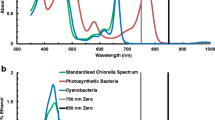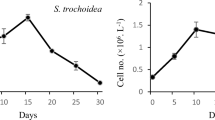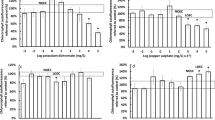Abstract
The application of biocides is a traditional method of controlling biodecay of outdoor cultural heritage. Chlorophyll degradation to phaeopigments is used to test the biocidal efficacy of the antimicrobial agents. In the present study, the usefulness of color measurements in estimating chlorophyll degradation was investigated. An aeroterrestrial stone biofilm-forming cyanobacterium of the genus Nostoc was chosen as test organism, comparing its different behaviour in both planktonic and biofilm mode of growth against the isothiazoline biocide Biotin T®. Changes in A435 nm/A415 nm and A665 nm/A665a nm and in the chlorophyll a and adenosine triphosphate (ATP) cell content were compared with the variations in the CIELAB color parameters (L*, a*, b*, C*ab and hab). Our findings showed that both the phaeophytination indexes are useful in describing degradation of chlorophyl a to phaeopigments. Moreover, the CIELAB color parameters represented an effective tool in describing chlorophyll degradation. L* CIELAB parameter appeared to be the most informative parameter in describing the biocidal activity of Biotin T® against Nostoc sp. in both planktonic and biofilm mode of growth.


Similar content being viewed by others
References
Acea MJ, Diz-Cid N, Prieto-Fernandez A (2001) Microbial populations in heated soils inoculated with cyanobacteria. Biol Fertil Soils 33(2):118–125
Acea MJ, Prieto-Fernandez A, Diz-Cid N (2003) Cyanobacterial inoculation of heated soils: effect on microorganisms of C and N cycles and on chemical composition in soil surface. Soil Biol Biochem 35(4):513–524
Agrawal SB (1992) Effect of supplemental UV-B radiation on photosynthetic pigment, protein and glutathione contents in green algae. Environ Exp Bot 32:137–143
Anderl JN, Franklin MJ, Stewart PS (2000) Role of Antibiotic penetration limitation in Klebsiella pneumoniae biofilm resistance to ampicillin and ciprofloxacin. Antimicrob Agents Chemother 44:1818–1824
Barnes JD, Balaguer L, Manrique E, Davison AW (1992) A reappraisal of the use of DMSO for the extraction and determination of chlorophyll a and b in lichens and higher plants. Environ Exp Bot 32:85–90
Batista JF, Pereira RFC, Lopes JM, Carvalho MFM, Feio MJ, Reis MAM (2000) In situ corrosion control in industrial water systems. Biodegradation 11(6):441–448
Bell RA, Sommerfeld MR (1986) Algal biomass and primary production within a temperature zone sandstone. Am J Bot 74:294–297
Cappitelli F, Abbruscato P, Foladori P, Zanardini E, Ranalli G, Principi P, Villa F, Polo A, Sorlini C (2009) Detection and elimination of Cyanobacteria from Frescoes: The case of the St. Brizio Chapel (Orvieto Cathedral, Italy). Microb Ecol 57:633–639
Carlson RE, Simpson J (1996) A coordinator’s guide to volunteer lake monitoring methods. North American Lake Management Society, Madison
Collier PJ, Ramsey AJ, Waigh RD, Douglas KT, Austin P, Gilbert P (1990) Chemical reactivity of some isothiazolone biocides. J Appl Bacteriol 69:578–584
CIE Publication 15-2. Colorimetry (1986) CIE Central Bureau, Vienna
Costerton JW (2007) The biofilm primer Springer. Springer, Berlin
De Muynck W, Maury Ramirez A, De Belie N, Verstraete W (2009) Evaluation of strategies to prevent algal fouling on white architectural and cellular concrete. Int Biodeterior Biodegrad 63(6):679–689
De Saravia SGG, Naranjo JDLP, Guiamet P, Arenas P, Borrego SF (2008) Biocide activity of natural extracts against microorganisms affecting archives. Boletin latinoamericano y del caribe de plantas medicinales y aromaticas 7(1):25–29
Dubosc A (2000) Etude du développement de salissures biologiques sur les parements en béton: mise au point d’essais accélérés de viellissement. Laboratoire Matériaux et Durabilité des Constructions. Toulouse (France), INSA
Escadeillas G, Bertron A, Ringot E, Blanc P, Dubosc A (2009) Accelerated testing of biological stain growth on external concrete walls. Part 2: quantification of growths. Mater Struct 42(7):937–945
Fonseca AMD (2009) Avaliação da eficácia de tratamentos convencionais e aplicações alternativas para prevenir a biodeterioração em património cultural. Dissertação de Mestrado em Conservação e Restauro. Departamento de Conservação e Restauro Faculdade de Ciências e Tecnologia, Universidade Nova de Lisboa
Gladis F, Eggert A, Karsten U, Schumann R (2010) Prevention of biofilm growth on man-made surfaces: evaluation of antialgal activity of two biocides and photocatalytic nanoparticles. Biofouling 26(1):89–101
Hall-Stoodley L, Costerton JW, Stoodley P (2004) Bacterial biofilms: from the natural environment to infectious diseases. Nat Rev Microbiol 2(2):95–108
Herasimenka Y, Cescutti P, Sampaio Noguera CE, Ruggiero JR, Urbani R, Impallomeni G, Zanetti F, Campidelli S, Prato M, Rizzo R (2008) Macromolecular properties of cepacian in water and in dimethylsulfoxide. Carbohydr Res 343(1):81–89
Hueck HJ (1965) The biodeterioration of materials as part of hylobiology. Material und Organismen 1(1):5–34
Lopez J, Retuerto R, Carballeira A (1997) D665/D665a index vs. frequencies as indicators of bryophyte response to physicochemical gradients. Ecology 78(1):261–271. Ecological Society of America, USA
Louda JW, Li J, Liu L, Winfree MN, Baker EW (1998) Chlorophyll-a degradation during cellular senescence and death. Org Geochem 29(5–7):1233–1251
Manrique E, Redondo EL, Seriña E, Izco J (1989) Estimation of chlorophyll degradation into phaeophytin in Anaptychia ciliaris as a method to detect air pollution. Lazaroa 11:141–148
Martínez-Abaigar J, Núñez-Olivera E (1998) Ecophysiology of photosynthetic pigments in aquatic bryophytes. In: Bates JW, Ashton NW, Duckett JG (eds) Bryology for the Twenty-first Century. Maney Publishing and the British Bryological Society, Leeds, pp 277–292
Martínez-Abaigar J, Otero S, Tomás R, Núñez-Olivera E (2008) High-level phosphate addition does not modify UV effects in two aquatic bryophytes. Bryologist 111(3):444–454
Pisani T, Paoli L, Gaggi C, Pirintsos SA, Loppi S (2007) Effects of high temperature on epiphytic lichens: Issues for consideration in a changing climate scenario. Plant Biosyst 141(2):164–169
Prieto B, Rivas T, Silva B (2002) Rapid quantification of phototrophic microorganisms and their physiological state through their colour. Biofouling 18:229–236
Prieto B, Silva B, Aira N, Laiz L (2005) Induction of biofilms on quartz surfaces as a means of reducing the visual impact of quartz quarries. Biofouling 21(5–6):237–246
Prieto B, Sanmartín P, Aira N, Silva B (2010) Color of cyanobacteria: some methodological aspects. Appl Opt 49:2022–2029
Principi P, Villa F, Bernasconi M, Zanardini E (2006) Metal toxicity in municipal wastewater activated sludge investigated by multivariate analysis and in situ hybridization. Water Res 40(1):99–106
Ricart M, Barceló D, Geiszinger A, Guasch H, de Alda ML, Romaní AM, Vidal G, Villagrasa M, Sabater S (2009) Effects of low concentrations of the phenylurea herbicide diuron on biofilm algae and bacteria. Chemosphere 76(10):1392–1401
Rippka R, Deruelles J, Waterbury JB, Herdman M, Stanier RY (1979) Generic assignments, strain histories and properties of pure cultures of cyanobacteria. J Gen Microbiol 111:1–61
Ronen R, Galun M (1984) Pigment extraction from lichens with dimethyl sulfoxide (DMSO) and estimation of chlorophyll degradation. Environ Exp Bot 24:239–245
Sanmartín P, Aira N, Devesa-Rey R, Silva B, Prieto B (2010) Relationship between color and pigment production in two stone biofilm-forming cyanobacteria (Nostoc sp. PCC 9104 and Nostoc sp. PCC 9025). Biofouling 26(5):499–509
Silkina A, Bazes A, Vouve F, Le Tilly V, Douzenel P, Mouget JL, Bourgougnon N (2009) Antifouling activity of macroalgal extracts on Fragilaria pinnata (Bacillariophyceae): A comparison with Diuron. Aquat Toxicol 94(4):245–254
Underwood GJC, Paterson DM (1993) Recovery of intertidal benthic diatoms after biocide treatment and associated sediment dynamics. J Mar Biol Assoc UK 73(1):25–45
UNESCO (2000) Unesco to protect masterpieces of the oral and intangible heritage of humanity. http://www.unesco.org/bpi/eng/unescopress/2000/00-48e.shtml
Wollenweider RA (1969) A manual on methods for measuring primary production in aquatic environments. IBP Handbook 12 Davis Co. 213
Wyszecki G, Stiles WS (1982) Color science, concepts and methods, quantitative data and formulae, 2nd edn. Wiley, New York
Xu KD, McFeters GA, Stewart PS (2000) Biofilm resistance to antimicrobial agents. Microbiology 146:547–549
Young ME, Alakomi HL, Fortune I, Gorbushina AA, Krumbein WE, Maxwell I, McCullagh C, Robertson P, Saarela M, Valero J, Vendrell M (2008) Development of a biocidal treatment regime to inhibit biological growths on cultural heritage: BIODAM. Env Geol 56(3–4):631–664
Acknowledgments
The present study was financed by Xunta de Galicia (REF: 09TMT014203PR) and Science and Education Ministry of Spain (MEC) (BES-2007-16996). The authors would like to thank Dr Pamela Principi for critically reading this manuscript.
Author information
Authors and Affiliations
Corresponding author
Rights and permissions
About this article
Cite this article
Sanmartín, P., Villa, F., Silva, B. et al. Color measurements as a reliable method for estimating chlorophyll degradation to phaeopigments. Biodegradation 22, 763–771 (2011). https://doi.org/10.1007/s10532-010-9402-8
Received:
Accepted:
Published:
Issue Date:
DOI: https://doi.org/10.1007/s10532-010-9402-8




